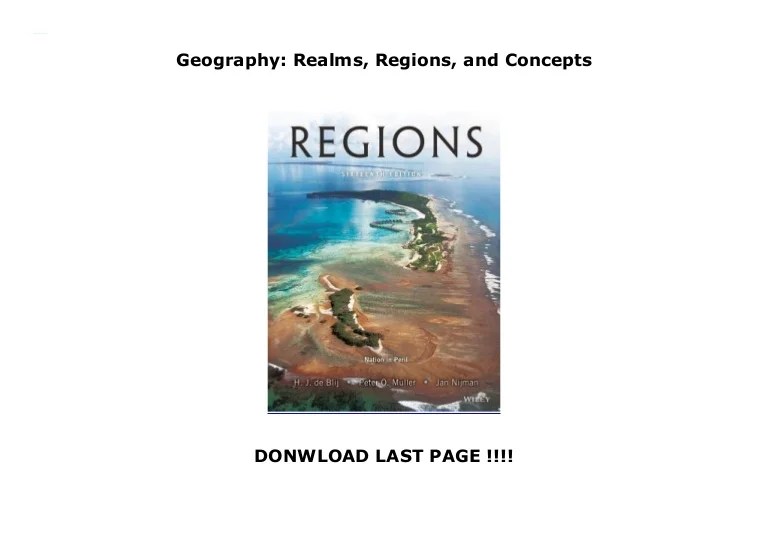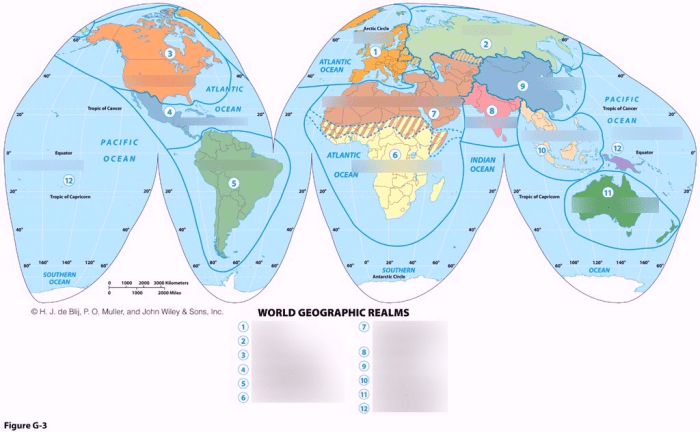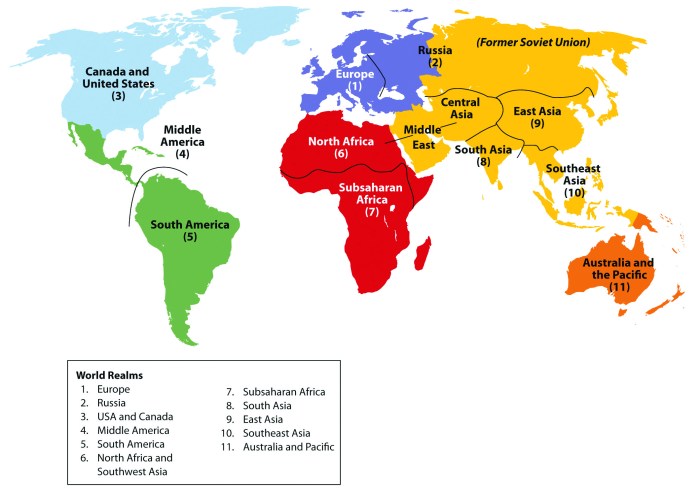Geography realms regions and concepts 18th edition pdf – Delving into the realm of geography, the 18th edition of Geography Realms, Regions, and Concepts presents a comprehensive exploration of the fundamental principles, diverse regions, and interconnected realms that shape our planet. This authoritative text embarks on a journey to unravel the intricate tapestry of geographical knowledge, providing a profound understanding of the discipline’s scope and applications.
From the foundational concepts of scale, space, and place to the analysis of real-world scenarios, this edition delves into the heart of geographical inquiry. It illuminates the distinct characteristics of major world regions, highlighting their physical and cultural landscapes. Moreover, it explores the realms of physical, human, and environmental geography, showcasing their interdisciplinary connections and methodologies.
Geographical Concepts
Geography is the study of the Earth’s surface and its inhabitants. It is a multidisciplinary field that draws on the natural and social sciences to understand the complex interactions between humans and their environment.
Fundamental concepts in geography include scale, space, and place. Scale refers to the level of detail at which a geographical phenomenon is studied. Space is the physical and social context in which geographical phenomena occur. Place is a specific location that has unique physical and cultural characteristics.
Geographical data can be classified into two main types: qualitative and quantitative. Qualitative data is non-numerical and describes the characteristics of a geographical phenomenon. Quantitative data is numerical and measures the magnitude of a geographical phenomenon.
Geographical concepts are applied in a wide range of real-world scenarios. For example, geographers use their knowledge of scale, space, and place to design maps and other visual representations of the Earth’s surface. They also use geographical data to analyze environmental problems, such as climate change and pollution.
Types of Geographical Data
- Qualitative data: Non-numerical data that describes the characteristics of a geographical phenomenon.
- Quantitative data: Numerical data that measures the magnitude of a geographical phenomenon.
Applications of Geographical Concepts
- Design of maps and other visual representations of the Earth’s surface.
- Analysis of environmental problems, such as climate change and pollution.
World Regions: Geography Realms Regions And Concepts 18th Edition Pdf

The world can be divided into a number of major regions, each with its own unique physical and cultural characteristics. The most common way to divide the world into regions is by continent. The seven continents are: Africa, Antarctica, Asia, Australia, Europe, North America, and South America.
Regions can also be defined by other criteria, such as climate, population, or economic development. For example, the world can be divided into tropical, temperate, and polar regions. It can also be divided into developed, developing, and least developed regions.
The different regions of the world have been shaped by a variety of historical and contemporary factors. These factors include climate, geography, culture, and economics.
Major World Regions
- Africa
- Antarctica
- Asia
- Australia
- Europe
- North America
- South America
Factors that Shape World Regions
- Climate
- Geography
- Culture
- Economics
Realms of Geography
Geography can be divided into three main realms: physical geography, human geography, and environmental geography.
Physical geography is the study of the Earth’s physical features, such as its landforms, climate, and vegetation. Human geography is the study of human activity on the Earth’s surface. Environmental geography is the study of the interaction between humans and their environment.
The different realms of geography are interconnected. For example, physical geography can influence human activity, and human activity can impact the environment.
Physical Geography, Geography realms regions and concepts 18th edition pdf
Physical geography is the study of the Earth’s physical features, such as its landforms, climate, and vegetation.
Human Geography
Human geography is the study of human activity on the Earth’s surface.
Environmental Geography
Environmental geography is the study of the interaction between humans and their environment.
Geographical Data and Analysis

Geographical data can be collected from a variety of sources, including field observations, surveys, and remote sensing. Once collected, geographical data can be analyzed using a variety of statistical and spatial analysis techniques.
Statistical analysis is used to describe the distribution of geographical data. Spatial analysis is used to identify patterns and relationships in geographical data.
Geographical data analysis is used to solve a wide range of real-world problems. For example, geographers use data analysis to identify areas that are at risk for natural disasters, to plan for transportation systems, and to develop strategies for economic development.
Types of Geographical Data
- Field observations: Data collected directly from the environment.
- Surveys: Data collected from people about their activities and opinions.
- Remote sensing: Data collected from satellites and other remote sensing devices.
Methods of Geographical Data Analysis
- Statistical analysis: Used to describe the distribution of geographical data.
- Spatial analysis: Used to identify patterns and relationships in geographical data.
Applications of Geographical Data Analysis
- Identify areas that are at risk for natural disasters.
- Plan for transportation systems.
- Develop strategies for economic development.
Case Studies

Case studies are a valuable tool for demonstrating the application of geographical concepts, methods, and data in different contexts.
Case studies can be used to analyze the strengths and weaknesses of different approaches to geographical research. They can also be used to discuss the ethical implications of geographical research and practice.
Examples of Case Studies
- The use of GIS to map the spread of a disease.
- The analysis of census data to identify areas of poverty.
- The evaluation of the environmental impact of a new development project.
Quick FAQs
What are the key geographical concepts covered in this edition?
This edition explores fundamental concepts such as scale, space, and place, providing a solid foundation for understanding geographical phenomena.
How does the text compare and contrast different world regions?
The book compares world regions based on factors like climate, population, economic development, and historical and contemporary influences, highlighting their unique characteristics and interconnections.
What is the scope of physical geography in this edition?
The text delves into the study of Earth’s physical features, processes, and interactions, including landforms, climate, water resources, and ecosystems.